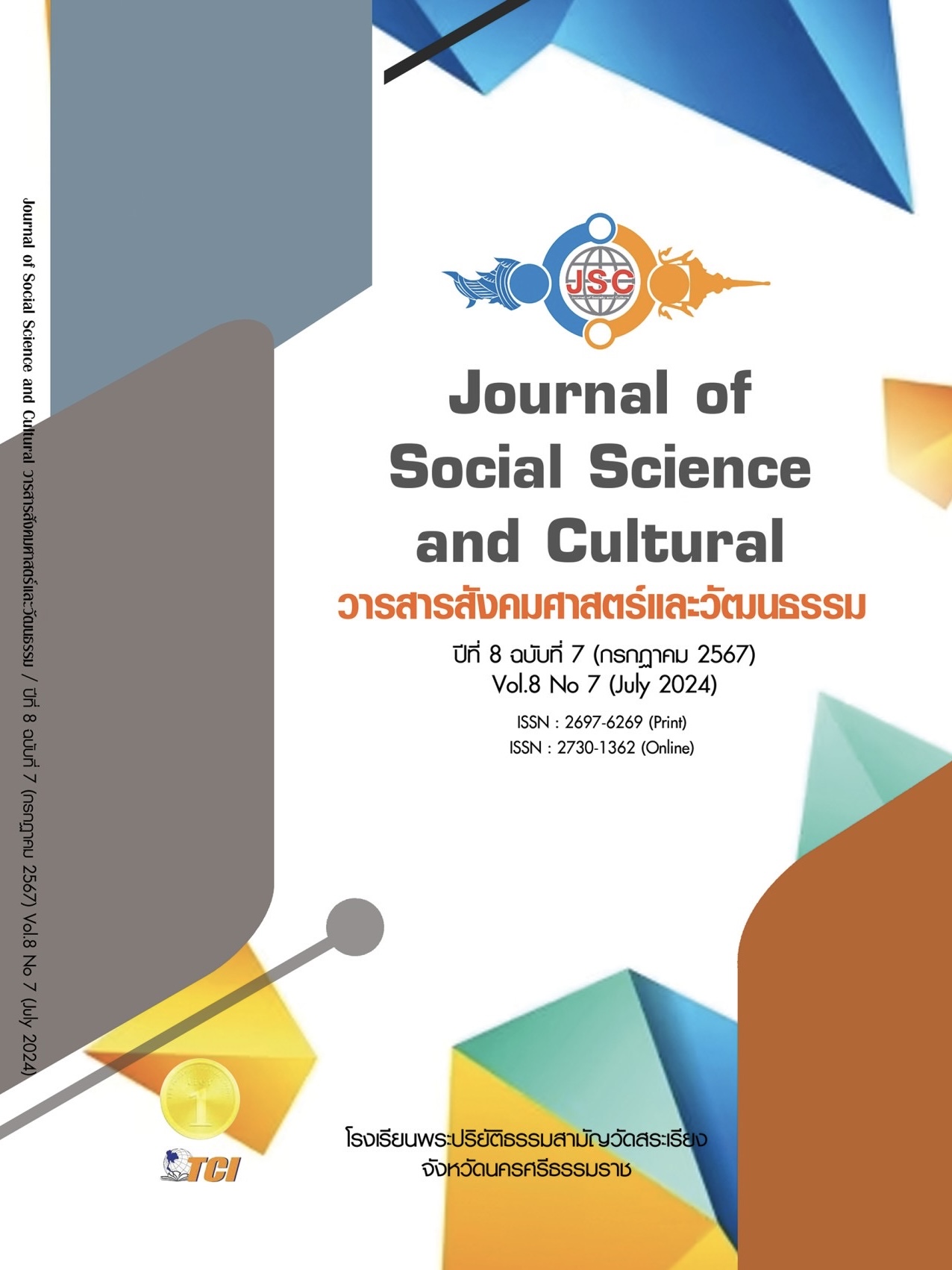CAUSAL RELATIONSHIPS OF EXTERNAL ENVIRONMENTAL FACTORS AND ADAPTABILITY AFFECTING THE COMPETITIVENESS OF TRANSPORTATION BUSINESSES
Main Article Content
Abstract
The objectives of this research are 1) to study the relationship between external environmental, The adaptability of the transportation business and competitiveness of transportation business 2) to examine the consistency of the developed model with empirical data 3) to present guidelines for external environmental factors and the ability to adapt affects the competitiveness of transportation business. This research used mixed methods research. The data was collected by specific sample group who was small transport business in the central region of Thailand, totaling 400 companies. Important information providers were executives and supervisors. Data were collected by questionnaires and in-depth interviews with 10 people. The confirmatory factor analysis and hypothesis testing were performed with structural equation analysis techniques and content analysis. The results found that the elements of the external environment and the ability to adapt affect causal relationships. It also had a direct and positive influence on the competitiveness of small business with significant at the statistical level .05. The harmony index results of the model have values CMIN/df = 1.50, p = 0.62, GFI = 0.987, AGFI = 0.954, RMSEA = 0.035, CFI = 998, NFI = 0.995. The model was consistent with empirical data. This is for guidelines for building the competitiveness of small transport businesses. the guidelines for creating competitive ability and important factors in the external environment of the organization which influence the competitiveness of the business. It is necessary to focus on learning and adapting to external factors, develop the organization's adaptability and human resource development. In addition, technology must be adjusted to increase operational efficiency, emphasizing adaptation that affects long-term competitiveness. As a result, the organization has potential and receives acceptance and trust from service users
Article Details
References
กรมพัฒนาธุรกิจการค้า. (2566). แหล่งค้นหาข้อมูลนิติบุคคล และประเภทธุรกิจในประเทศไทย. เรียกใช้เมื่อ 18 พฤศจิกายน 2567 จาก https://datawarehouse.dbd.go.th/
กัลยา วานิชย์บัญชา. (2560). การวิเคราะห์สถิติชั้นสูงด้วย SPSS for Window. (พิมพ์ครั้งที่ 12). กรุงเทพมหานคร: ห้างหุ้นส่วนจํากัด สามลดา.
ธนาคารแห่งประเทศไทย. (2566). รายงานแนวโน้มเศรษฐกิจไทยและเศรษฐกิจโลก. กรุงเทพมหานคร: ธนาคารแห่งประเทศไทย.
ธานินทร์ ศิลป์จารุ. (2557). การศึกษาและการวิเคราะห์ข้อมูลทางสถิติด้วย SPSS. กรุงเทพมหานคร: วีอินเตอร์พริ้นทร์.
นงลักษณ์ วิรัชชัย. (2542). โมเดลลิสเรลสถิติวิเคราะห์สำหรับการวิจัย. กรุงเทพมหานคร: จุฬาลงกรณ์มหาวิทยาลัย.
บุญธรรม กิจปรีดาบริสุทธิ์. (2551). ระเบียบวิธีการวิจัยทางสังคมศาสตร์. (พิมพ์ครั้งที่ 10). กรุงเทพมหานคร: จามจุรีโปรดักท์.
เบญจวรรณ เปี่ยมสุวรรณ และพภัสสรณ์ วรภัทร์ถิระกุล. (2563). ความสามารถทางการแข่งขันโดยใช้เทคโนโลยีสารสนเทศของ บริษัท ขนส่ง จำกัด. วารสารสังคมศาสตร์และมานุษยวิทยาเชิงพุทธ, 5(5), 114-129.
ประจักษ์ พรมงาม และคณะ. (2565). ความสามารถทางการแข่งขันปัจจัยที่มีอิทธิพลต่อความสำเร็จธุรกิจขนส่งขนาดกลางและขนาดย่อม. วารสารวิทยาการปริทัศน์, 24(3), 187-198.
ยุทธ ไกยวรรณ์. (2556). การวิเคราะห์โมเดลสมการโครงสร้างด้วย AMOS. กรุงเทพมหานคร: จุฬาลงกรณ์มหาวิทยาลัย.
ลัดดาวัลย์ เพชรโรจน์ และอัจฉรา ชำนิประศาสน์. (2547). ระเบียบวิธีการวิจัย. กรุงเทพมหานคร: พิมพ์ดีการพิมพ์.
วัลลี พุทโสม. (2564). แบบจำลองปัจจัยเชิงสาเหตุของความสามารถในการปรับตัวกับผลการดำเนินงานและความอยู่รอดของผู้ประกอบการธุรกิจขนาดเล็กในสาถานการณ์โควิด-19. วารสารวิทยาลัยดุสิตธานี, 15(2), 129-144.
ศิวกร อโนรีย์. (2564). ปัจจัยที่มีผลต่อความได้เปรียบทางการแข่งขัน และความสำเร็จของผู้ประกอบการวิสาหกิจขนาดกลางและขนาดย่อมในเขตจังหวัดราชบุรี. ใน ดุษฎีนิพนธ์บริหารธุรกิจมหาบัณฑิต สาขาศิลปากรบริหารธุรกิจ. มหาวิทยาลัยศิลปากร.
สำนักงานกองทุนสนับสนุนการสร้างเสริมสุขภาพ. (2567). โครงการเสริมสร้างสุขภาวะในองค์กรเพื่อพัฒนาคุณภาพชีวิตในการทำงานแก่บุคลากรในกลุ่มธุรกิจขนส่ง (ปี 2566 - 2567). กรุงเทพมหานคร: สำนักสนับสนุนสุขภาวะองค์กร (สน.8).
สำนักงานคณะกรรมการพัฒนาการเศรษฐกิจและสังคมแห่งชาติ. (2560). ยุทธศาสตร์ชาติ 20 ปี (พ.ศ. 2561 - 2580). กรุงเทพเทพมหานคร: สำนักงานคณะกรรมการพัฒนาการเศรษฐกิจและสังคมแห่งชาติ.
สำนักงานนโยบายและแผนการขนส่งและจราจร. (2566). รายงานสถานการณ์การขนส่งและโลจิสติกส์ประจำปี 2566. กรุงเทพเทพมหานคร: สำนักงานนโยบายและแผนการขนส่งและจราจร.
สินใจ สีลิปะเสิด และเสาวลักษณ์ จิตติมงคล. (2565). ผลกระทบการจัดการด้านโลจิสติกส์ต่อขีดความสามารถในการแข่งขันของธุรกิจโลจิสติกส์ในประเทศไทย. วารสารมหาวิทยาลัยราชภัฏร้อยเอ็ด, 17(1). 193-207.
สุชาดา บุญเรือง และคณะ. (2564). แนวทางการจัดการเพื่อเพิ่มความสามารถในการแข่งขันธุรกิจบริการขนส่งไทย. วารสารรัชต์ภาคย์, 15(43), 352-362.
สุภมาส อังศุโชติ และคณะ. (2557). สถิติวิเคราะห์สำหรับการวิจัยทางสังคมศาสตร์และพฤติกรรมศาสตร์: เทคนิคการใช้โปรแกรม LISREL. (พิมพ์ครั้งที่ 4). กรุงเทพมหานคร: เจริญดีมั่นคงการพิมพ์.
สุภางค์ จันทวานิช. (2553). การวิเคราะห์ข้อมูลเชิงคุณภาพ. กรุงเทพมหานคร: สำนักพิมพ์จุฬาลงกรณ์มหาวิทยาลัย.
ไอยเรศ วงษ์วัฒนพงษ์. (2563). ปัจจัยที่มีอิทธิพลต่อผลการดำเนินธุรกิจของผู้ให้บริการขนส่งสินค้าข้ามแดนในกลุ่มประเทศกัมพูชา ลาว เมียนมา และ เวียดนาม (CLMV). ใน วิทยานิพนธ์วิทยาศาสตรมหาบัณฑิต สาขาวิชาการจัดการโลจิสติกส์และโซ่อุปทาน. มหาวิทยาลัยศรีปทุม.
Çitilci, T. & Akbalık, M. (2020). The importance of PESTEL analysis for environmental scanning process. In Dinçer, H. & Yüksel, S. (eds.), Handbook of research on decision-making techniques in financial marketing (pp. 336-357). Hershey, PA: IGI Global.
Hair, J. F. et al. (1998). Multivariate data analysis. (5th ed.). New York: Macmillan.
Hitt, M. A. et al. (2011). Strategic entrepreneurship: creating value for individuals, organizations, and society. Academy of management perspectives, 25(2), 57-75.
Rushton, A. et al. (2017). The handbook of logistics and distribution management: Understanding the supply chain. London, UK: Kogan Page Publishers.
Rwakira, B. T. (2015). Supply chain resilience: a case study analysis of a supply network in a developing country context. In Doctoral dissertation. Lancaster University.
Schumacker, R. E. & Lomax, R. G. (1996). A beginner’s guide to Structural modeling. Mahwah, NJ: Erlbaum.
Wang, M. et al. (2020). Logistics innovation capability and its impacts on the supply chain risks in the industry 4.0 era. Modern Supply Chain Research and Applications, 2(2), 83-98.
Wang, X. & Zhang, Y. (2018). The application of big data in logistics and supply chain management. Journal of Cleaner Production, 201(2018), 1192-1200.
Yang, Z. et al. (2020). Identifying intercity freight trip ends of heavy trucks from GPS data. Transportation Research Part E: Logistics and Transportation Review, 157(2022), 102590. https://doi.org/10.1016/j.tre.2021.102590.
Zhang, Y. et al. (2015). Research on financing risk management of logistics enterprises under supply chain financing mode. American Journal of Industrial and Business Management, 5(12), 760-767.

